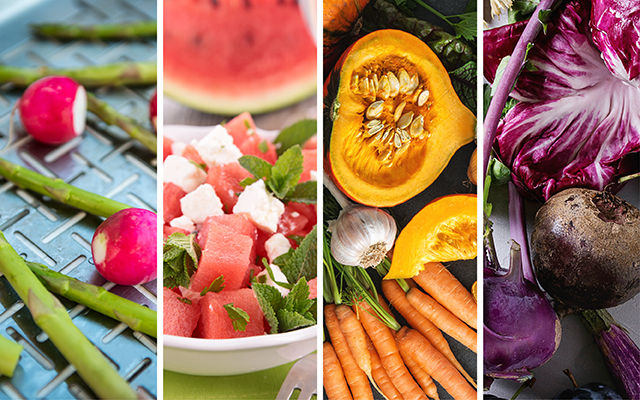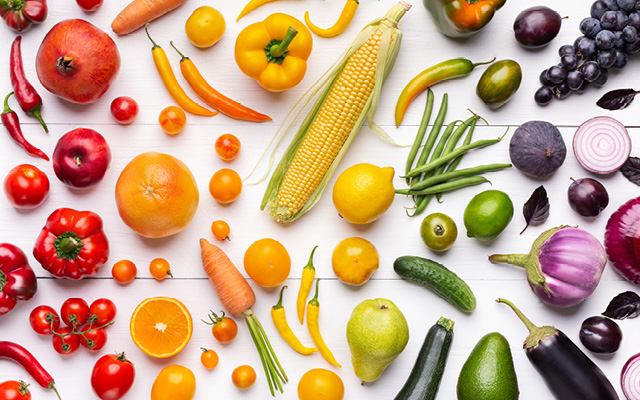Tucked into a comfortable older neighborhood in south Minneapolis, Birchwood Cafe is a popular eatery known for its commitment to local, sustainable food — a value evident in its dynamic menu, which changes every season. Tracy Singleton, Birchwood’s owner, is active in the ever-growing farm-to-table movement, which emphasizes the connection between the sustainability of the land and its harvest, and the health of the individuals and communities nourished by that seasonal bounty.
Singleton grew up on highly processed, heat-and-eat fare in the late ’70s and wasn’t always in tune with these interconnections. “It wasn’t until I started eating real food, harvested in season and cooked from scratch, that I discovered what it means to have a relationship with what you’re eating,” she says. “It’s not just about fueling your body. It’s about nourishing your mind, your energy, your spirit, your community.”
This way of eating — as seasonally and as close to the source as possible — is not only a way to feel more connected to your food. It’s also more environmentally sustainable than eating food grown and shipped from afar. Plus, research shows that the fruits (and vegetables) of the farmers’ labors are often more nutritionally dense.
Ancient health traditions such as Indian Ayurveda and Traditional Chinese Medicine (TCM) hold that our bodies and minds are primed to receive different types of nourishment in rhythm with nature’s cycles, and that seasonal eating aligns with these shifts within our bodies. Many integrative Western practitioners agree.
“Nature gives us what we need, when we need it,” says Elson Haas, MD, founder and director of the Preventive Medical Center in San Rafael, Calif., and author of Staying Healthy With the Seasons. “Seasonal choices are meant to balance us out. That’s why eating a salad in the dead of winter sometimes feels odd, compared with having one in summer. Yes, you’re getting nutrients, but it might not feel like what you need on a deeper level.”
Traditionally in Tune
TCM practitioners view seasonally available foods as both protective and balancing. Throughout the year, external changes in weather, as well as internal shifts in our emotions and energy, influence our dietary needs and preferences, says Haas.
When the weather is warm and dry, for instance, we crave cool and juicy foods — think of summers rife with watermelon, cucumbers, leafy greens, and tomatoes. Chillier weather inspires food choices that are dense and warming, such as root vegetables and darker greens. Spring selections lean toward detoxifying leafy greens, asparagus, radishes, and spinach.
“Eating what’s in season is one of the basic nutritional guidelines we would all be wise to follow,” says Haas.
The Ayurveda system views an individual’s health through that person’s dosha, a constitutional quality comprising physical, mental, and energetic characteristics. The doshas correlate to the five elements of air, fire, water, ether, and earth — and to the seasons, as well, explains Sarah Kucera, DC, founder of Sage Center for Yoga and Healing Arts in Kansas City, Mo. Understanding the relationships between these internal and external factors can help address health imbalances.
Like TCM, Ayurveda seeks to harmonize health, reduce inflammation, and improve digestion via an “opposites approach”: Winter foods are oily and warm — think rich stews, steamy oatmeal topped with butter, and root vegetables roasted in ghee or olive oil. Summer foods, such as melons and cucumber, are light, cooling, and easy on the digestive system.
“People think of winter weight gain as having to do with eating more during the holidays, and that may have something to do with it,” says Hatipoglu. “But it also has to do with this hibernation mode.”
Seasons indeed bring cyclical changes in our metabolism, just as they do in other animals, says Cleveland Clinic endocrinologist Betul Hatipoglu, MD. Woodland animals, for example, shift into an insulin-resistant state to burn fuel more efficiently in the winter, enabling them to eat less when resources are scarce. Humans experience a similar shift to mild insulin resistance as part of an ingrained survival mechanism from our hunter–gatherer days.
“People think of winter weight gain as having to do with eating more during the holidays, and that may have something to do with it,” says Hatipoglu. “But it also has to do with this hibernation mode.”
In the fall, our livers increase fat production to prepare us for winter, ramping up glucose production for use by the brain, she explains. This annual insulin cycle switches back to an insulin-sensitive state in late winter in preparation for summer’s abundance.
“A few pounds of fluctuation may be part of the normal rhythm of nature,” says Hatipoglu.
This Western understanding syncs with the focus on liver health seen in both TCM and Ayurveda, says Haas. Spring is the “cleansing and healing season,” filled with detoxifying foods, such as spinach and other fresh greens, as well as wild options like dandelion greens and chicory.
“What it comes down to is this: What does your body need right now?” he says. “Does it need to be warmed? Does it need to feel lighter? The answers are highly individual, but focusing on seasonal eating in general can help you find a personal solution to those questions.”
To Everything, a Season
Oranges and pomegranates in July, asparagus and peppers in January: Thanks to transport-refrigeration technology, most supermarkets offer our favorites year-round. But when we consume produce shipped across the country (or around the world), we may be shortchanging ourselves nutritionally.
In anticipation of long-distance travel, growers harvest some crops — typically fruits — at an immature state to reduce damage during shipping. (Some fruits continue to ripen after harvesting; others, including most vegetables, will never be more ripe than the moment they’re picked.)
Once produce is harvested, distributors have a narrow window to get it to market before it becomes overripe and starts to rot. By the time many veggies and fruits arrive in stores, sit on display for a few days, and then languish in our refrigerators, they’ve often lost much of their nutritional value. (Frozen produce offers fully ripened vegetables and fruits any time of the year; for more on this, see “Beyond the Harvest” below.)
While you may crave brightly colored, phytonutrient-rich vegetables and fruits during the summer, in the colder months your body often asks for different produce and grains to support you through the winter. “Our digestive cycles are related to circadian rhythms,” says Kucera. “In the winter, our bodies are better able to accommodate heavier foods such as potatoes, as well as grains.”
“Our digestive cycles are related to circadian rhythms,” says Kucera. “In the winter, our bodies are better able to accommodate heavier foods such as potatoes, as well as grains.”
Even animal products can be considered seasonal. Modern refrigeration and freezing technology (as well as livestock operations that rely on dried grains) mean that virtually any meat or dairy we want is available whenever we want it. But these mechanisms circumvent nature’s rhythms.
Wild game and fish are still regarded as seasonal foods, says Sean Sherman, founder of The Sioux Chef, an organization focused on revitalizing Native American cuisine. He notes that hunting and fishing seasons coincide with the months when the animals and fish have completed their reproduction cycles and — from the human perspective — are at their nutritional peak.
“If you look at how people who hunt or fish for sustenance operate, they choose to harvest these animals when they’re most nutritionally dense,” explains Sherman, author of The Sioux Chef’s Indigenous Kitchen. For example, deer aren’t hunted in winter or early spring, when they’re depleted from the cold season; they’re harvested in autumn, after months of eating nutrient-rich grasses.
Farmed animals also have a “season” if they’re raised on pasture instead of in feedlots, adds nutritionist and educator John Bagnulo, PhD, MPH. This applies to dairy from grassfed animals as well, he says, because cattle, sheep, and goats eat fresh grasses in warmer months, before switching over to dried grasses.
“Refrigeration has thrown some of this out the window,” Bagnulo says. “But there’s definitely a benefit to eating an animal, and the products from an animal, such as dairy, when it’s at its most nourished.”
The Seasonal Gut
When you expand the variety of foods you eat and rotate them seasonally, your gut benefits from a more varied, dynamic population of health-supporting bacteria.
The fiber in vegetables, fruits, and some grains, as well as the probiotics in fermented foods, boosts gut health. By extension, it improves the resiliency of your immune system. (For details on how this works, see “Healthy Gut, Healthy Brain“.)
“The microbiome definitely changes as the seasons do,” says Bagnulo. “In the summer, you’re likely to have bacteria in your gut that thrives on raw vegetables, while in the winter, you may have bacteria that’s more geared toward starchy foods.”
“The microbiome definitely changes as the seasons do,” says Bagnulo. “In the summer, you’re likely to have bacteria in your gut that thrives on raw vegetables, while in the winter, you may have bacteria that’s more geared toward starchy foods.”
Thinking about seasonality also makes it easier to escape “food ruts,” adds nutritionist Deanna Minich, PhD, author of The Rainbow Diet, referring to the common habit of eating roughly the same lineup of foods all year. To avoid falling into a single-season food slump, she recommends a sense of adventure: Try one or two unfamiliar vegetables or fruits weekly.
As your gut becomes happier, it’s likely you will, too. Research shows there’s a strong link between gut health and mental well-being.
“Our physiology becomes our psychology, and vice versa,” Minich explains. “When we change what we provide to the body, we become different emotionally.”
Other gut-related benefits include a lower risk of allergies, less inflammation, more protection against oxidative stress, and a wider range of nutrients.
Community and Connection
On the wall of Birchwood Cafe is a Zen meal prayer that illuminates the importance of awareness and relationship when eating: “Innumerable measures bring us this food. We should know how it comes to us.”
Singleton has found that when people learn about the actual farms where she sources her vegetables, meats, and dairy, they have a greater appreciation of the meals made from those ingredients. The same phenomenon can occur when we acknowledge the cyclical changes of the seasons themselves, each packed with its own nuances and abundance. We find peace in our place as well as our bellies.
“Eating this way has helped me become a whole, more happy person,” says Singleton. “Food is so much more than a combination of nutrient components. It’s a connection point to others, to nature, and to myself.”
Adaptive Superpowers
Eating local, seasonally available foods is not only a great way to optimize nutrition and flavor; it may also help us adapt to our environment. “Many fruits, for instance, contain high levels of antioxidants and polyphenolics that offer protection against UV light when it is at its greatest intensity — in the summer,” says John Bagnulo, PhD, MPH.
Knowing where foods are grown naturally is instructive, Bagnulo says. “They don’t grow flaxseed in the tropics. But what they do grow is coconuts, the nutrients of which provide a ton of protection against intense UV light. Eating foods from where you live is adaptive. You’re adapting to your environment.”
Beyond the Harvest
It’s easy to embrace seasonal eating when the farmers’ market is in full swing. But while folks in temperate climates can enjoy local, seasonal food year-round, many others have to be flexible.
“Although the word ‘moderation’ feels overused, it’s the best term for what to practice,” says Ayurvedic practitioner Sarah Kucera, DC. “You simply can’t become too rigid about only eating seasonally. Besides, maybe what you want to eat is in season someplace else — and could be bringing balance to your current state of health.”
Fermented foods are a good way to preserve ripe produce — and provide gut-boosting probiotics year-round.
There are some veggies and fruits, such as dark leafy greens and blueberries, that are worth including year-round because they’re such nutritional powerhouses.
You can also take advantage of frozen and canned options, suggests Terry Wahls, MD, author of The Wahls Protocol. Frozen produce is typically picked and packaged at peak nutrition, making it a better choice than under-ripe fresh produce shipped long distances. These options can sometimes be gentler on the budget, too, she notes, helping you expand your choices when seasonal picks are limited.
“If your starting point with this way of eating is just to get more vegetables, then you might begin with affordable frozen favorites,” Wahls advises.
And there are some veggies and fruits, such as dark leafy greens and blueberries, that are worth including year-round because they’re such nutritional powerhouses, says John Bagnulo, PhD, MPH.
“The value you get from especially nutrient-dense foods sometimes goes beyond seasonality,” he notes. “It makes sense to include a few of those choices all year, because it’s harder to fill those nutritional gaps without them.”




This Post Has 0 Comments